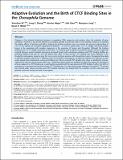| dc.contributor.author | Chen, Sidi | |
| dc.contributor.author | Ni, Xiaochun | |
| dc.contributor.author | Long, Manyuan | |
| dc.contributor.author | Negre, Nicolas | |
| dc.contributor.author | Zhang, Yong E. | |
| dc.contributor.author | White, Kevin P. | |
| dc.date.accessioned | 2013-02-21T19:28:54Z | |
| dc.date.available | 2013-02-21T19:28:54Z | |
| dc.date.issued | 2012-11 | |
| dc.date.submitted | 2011-12 | |
| dc.identifier.issn | 1544-9173 | |
| dc.identifier.issn | 1545-7885 | |
| dc.identifier.uri | http://hdl.handle.net/1721.1/77185 | |
| dc.description.abstract | Changes in the physical interaction between cis-regulatory DNA sequences and proteins drive the evolution of gene expression. However, it has proven difficult to accurately quantify evolutionary rates of such binding change or to estimate the relative effects of selection and drift in shaping the binding evolution. Here we examine the genome-wide binding of CTCF in four species of Drosophila separated by between ~2.5 and 25 million years. CTCF is a highly conserved protein known to be associated with insulator sequences in the genomes of human and Drosophila. Although the binding preference for CTCF is highly conserved, we find that CTCF binding itself is highly evolutionarily dynamic and has adaptively evolved. Between species, binding divergence increased linearly with evolutionary distance, and CTCF binding profiles are diverging rapidly at the rate of 2.22% per million years (Myr). At least 89 new CTCF binding sites have originated in the Drosophila melanogaster genome since the most recent common ancestor with Drosophila simulans. Comparing these data to genome sequence data from 37 different strains of Drosophila melanogaster, we detected signatures of selection in both newly gained and evolutionarily conserved binding sites. Newly evolved CTCF binding sites show a significantly stronger signature for positive selection than older sites. Comparative gene expression profiling revealed that expression divergence of genes adjacent to CTCF binding site is significantly associated with the gain and loss of CTCF binding. Further, the birth of new genes is associated with the birth of new CTCF binding sites. Our data indicate that binding of Drosophila CTCF protein has evolved under natural selection, and CTCF binding evolution has shaped both the evolution of gene expression and genome evolution during the birth of new genes. | en_US |
| dc.language.iso | en_US | |
| dc.publisher | Public Library of Science | en_US |
| dc.relation.isversionof | http://dx.doi.org/10.1371/journal.pbio.1001420 | en_US |
| dc.rights | Creative Commons Attribution | en_US |
| dc.rights.uri | http://creativecommons.org/licenses/by/2.5/ | en_US |
| dc.source | PLoS | en_US |
| dc.title | Adaptive Evolution and the Birth of CTCF Binding Sites in the Drosophila Genome | en_US |
| dc.type | Article | en_US |
| dc.identifier.citation | Ni, Xiaochun et al. “Adaptive Evolution and the Birth of CTCF Binding Sites in the Drosophila Genome.” Ed. Harmit S. Malik. PLoS Biology 10.11 (2012). | en_US |
| dc.contributor.department | Massachusetts Institute of Technology. Department of Biology | en_US |
| dc.contributor.department | Koch Institute for Integrative Cancer Research at MIT | en_US |
| dc.contributor.mitauthor | Chen, Sidi | |
| dc.relation.journal | PLoS Biology | en_US |
| dc.eprint.version | Final published version | en_US |
| dc.type.uri | http://purl.org/eprint/type/JournalArticle | en_US |
| eprint.status | http://purl.org/eprint/status/PeerReviewed | en_US |
| dspace.orderedauthors | Ni, Xiaochun; Zhang, Yong E.; Nègre, Nicolas; Chen, Sidi; Long, Manyuan; White, Kevin P. | en |
| mit.license | PUBLISHER_CC | en_US |
| mit.metadata.status | Complete | |
